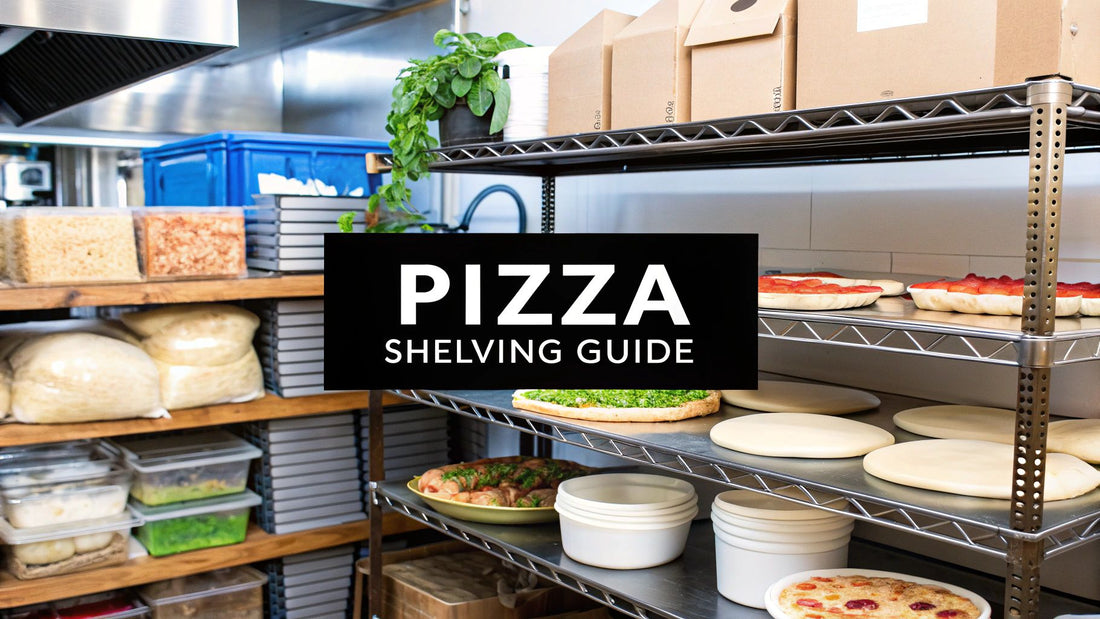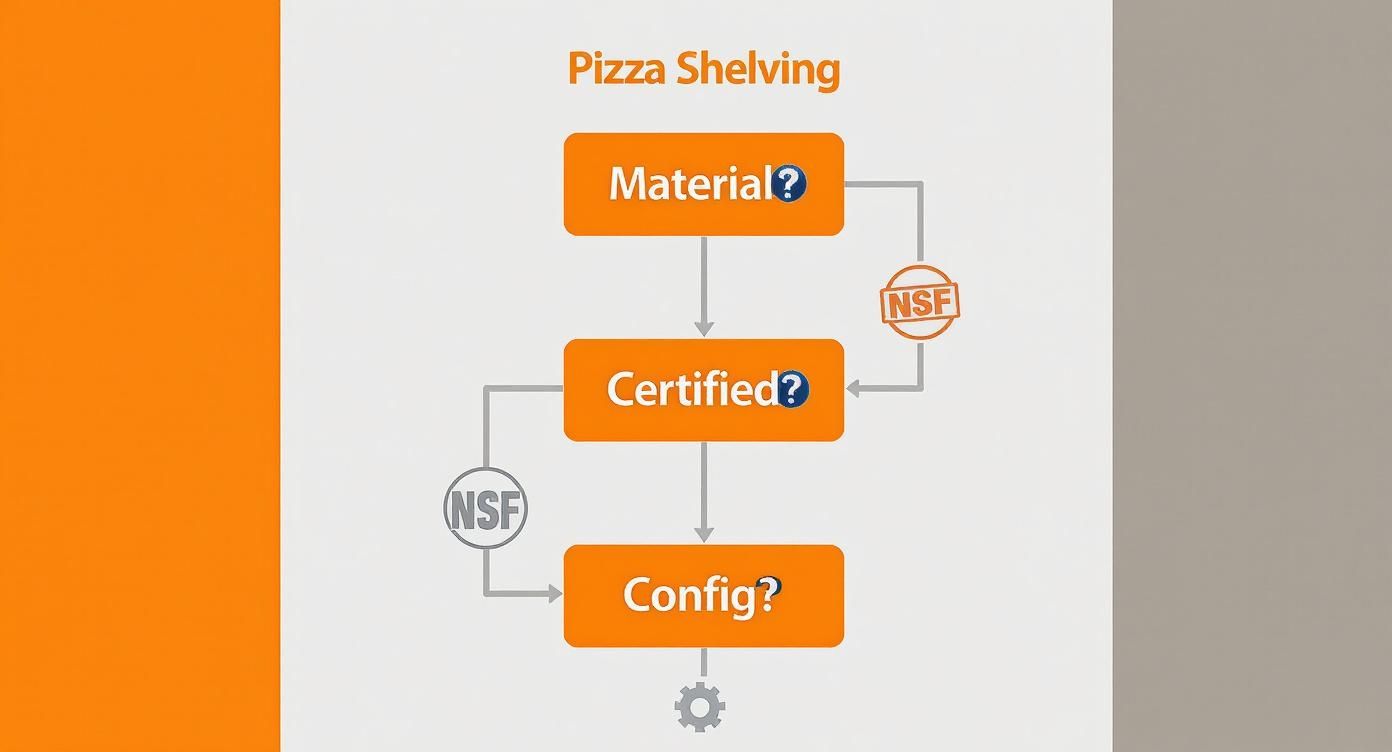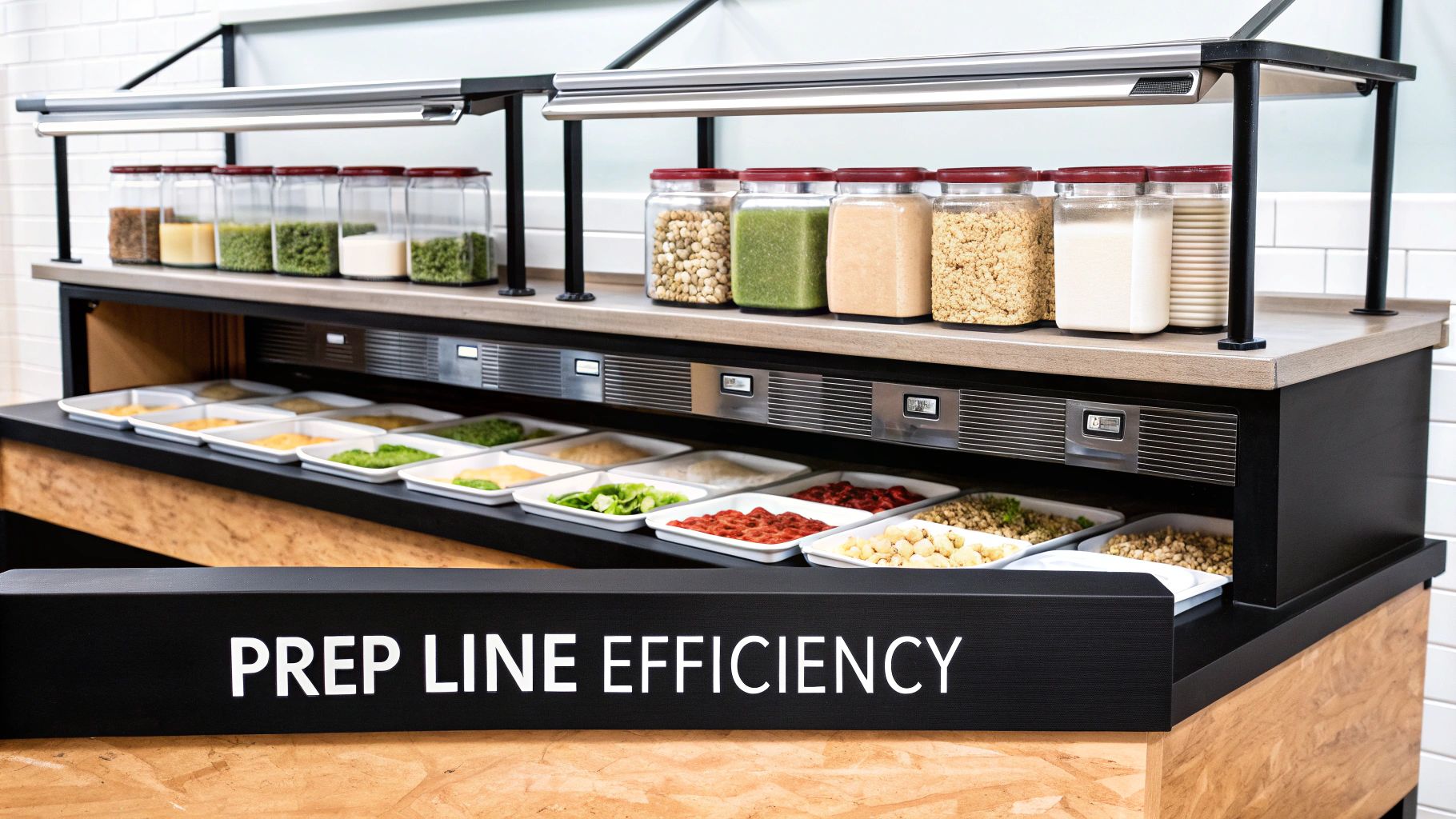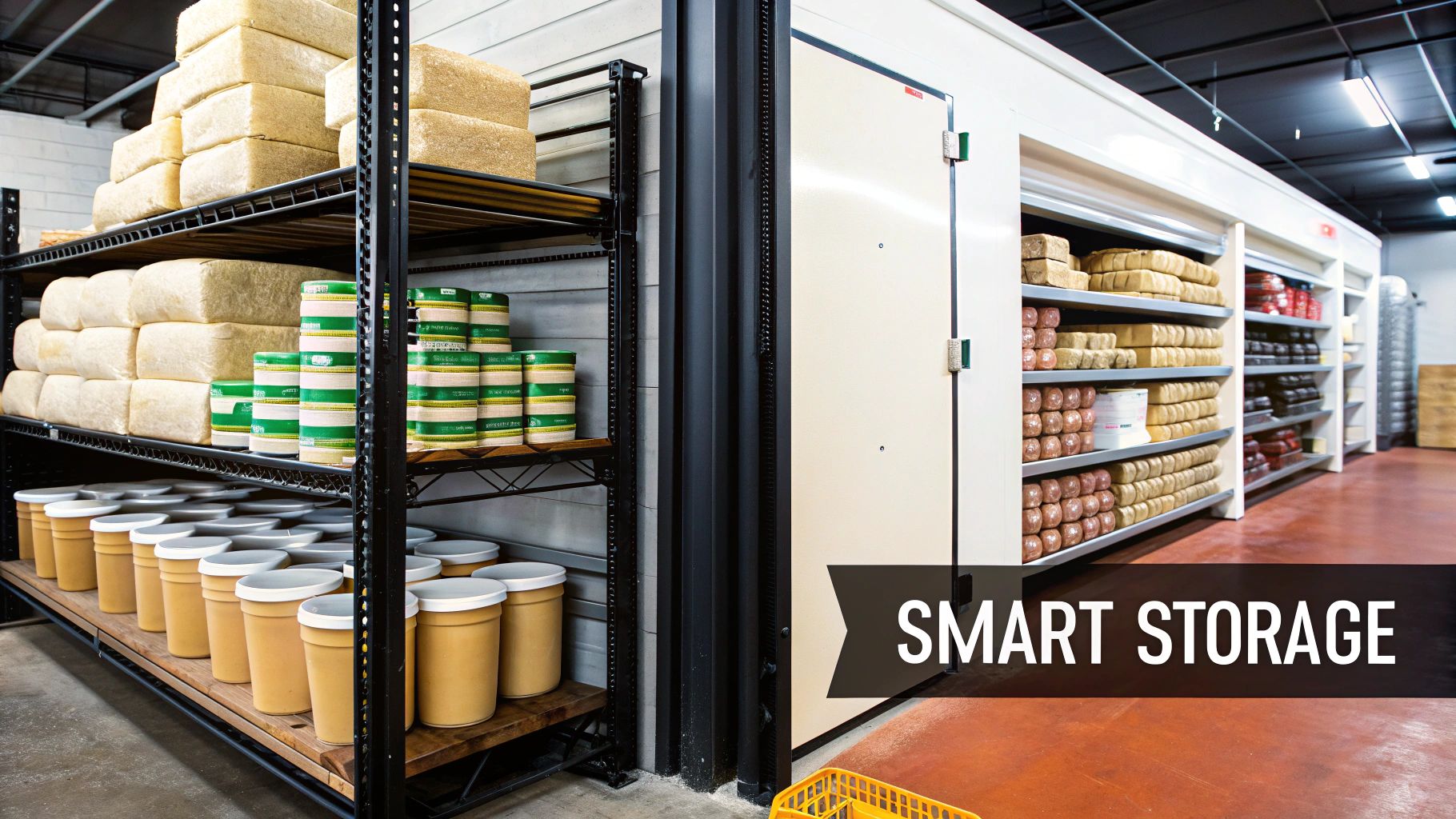
Pizza Shops: Your Guide to Commercial Kitchen Shelving
Share
In a busy pizza shop, every second counts. The right commercial kitchen shelving isn't just a place to stash ingredients; it's the structural backbone of your whole operation, driving speed, safety, and efficiency from the first toss of dough to the final boxed pie, especially around your pizza prep tables.
The Foundation of an Efficient Pizza Kitchen
Think of your pizza kitchen like a high-performance race car. Every single part has to work in perfect harmony to win the race against the dinner rush. In this picture, your shelving is the chassis—it holds everything together, letting the engine (your team and ovens) fire on all cylinders. Standard, flimsy shelving from a big-box store just can't handle the heat of a pizzeria.
A typical pizzeria's inventory is a mix of things that are incredibly heavy and need specific storage conditions. Residential-grade or light-duty shelving will buckle under that kind of pressure, creating a mess of safety hazards and operational chaos. The right setup, though, completely transforms your workspace, turning your pizza prep table into a model of efficiency.
Unique Storage Demands of a Pizzeria
The sheer weight and bulk of ingredients in a pizza restaurant are no joke. That's why strategic commercial kitchen shelving is built to handle these very specific challenges, like:
- Heavy Dough Boxes: Stacks of proofing dough are dense and heavy, demanding shelves that can take that concentrated weight without bowing or breaking a sweat, often stored under or near the pizza prep table.
- Bulk Flour and Ingredients: A single 50lb bag of flour needs a sturdy, accessible home. Add in cases of canned tomatoes, blocks of cheese, and jugs of olive oil, and you're talking about hundreds of pounds of storage load.
- Pizza Pan Organization: You've got endless stacks of pans in all different sizes. They need to be organized and within arm's reach for your cooks when the tickets start flying.
A well-organized shelving system has a direct impact on your bottom line. It cuts down on ingredient waste, lowers the risk of expensive workplace accidents, and shaves precious seconds off ticket times by creating a smooth, logical workflow from the pizza prep table to the oven.
This need for smarter, stronger kitchen spaces is showing up in the market, too. The commercial cooking equipment world is set to grow by USD 4.8 billion between 2024 and 2029, fueled by the push for efficiency in businesses just like pizzerias. As more kitchens get serious about streamlining their operations, solid storage becomes a non-negotiable investment.
The principles of smart storage are universal, whether you're outfitting a huge restaurant or figuring out food truck shelving strategies.
Choosing Your Shelving Material Wisely
Picking the right commercial kitchen shelving is a lot like choosing tires for a car. You wouldn't put racing slicks on a truck heading off-road, and you shouldn't put the wrong shelf in the wrong part of your pizza kitchen. Get it right, and everything runs smoothly. Get it wrong, and you're looking at rust, collapses, and some very unhappy health inspectors.
Each zone in a busy pizza kitchen—from the scorching pizza prep table to the humid walk-in cooler—has its own unique demands. Your shelving choice has to match the environment, or it’s just not going to last.
The Right Shelf for the Right Zone
The first step is always matching the material to its environment. Stainless steel is the undisputed champion for heavy-duty work around the pizza prep table. Think about where you're storing that 60-quart mixer or stacking heavy tubs of dough. That’s where stainless steel belongs. It’s built to take a beating day in and day out near your pizza prep line.
But take that same stainless steel shelf and put it in a damp walk-in cooler, and you'll eventually see corrosion. That's where polymer shelving really shines. Made from a tough, high-impact plastic, polymer is completely rust-proof. It’s the perfect choice for storing cheese, sauce, and prepped toppings in high-humidity areas without a second thought.
Then you have the dry storage room, home to sacks of flour and stacks of canned goods. This is the ideal spot for chrome-plated shelving. It offers a budget-friendly solution and looks great, but it has one major weakness: moisture. Expose chrome to water or steam, and rust will appear almost overnight. It must be kept in completely dry zones.
This decision tree infographic is a great way to visualize the process. It walks you through the key questions you need to ask to land on the right material and setup for your pizza kitchen.

As you can see, it all boils down to two things: how much moisture the area gets and how much weight the shelf needs to hold. Answering those two questions will almost always point you to the right material for your pizzeria.
Choosing shelving isn't just a storage decision; it's a long-term investment in your kitchen's workflow and safety. The initial cost difference between materials becomes insignificant when you factor in the replacement costs and safety risks of using the wrong type of shelf in a critical area like your pizza prep station.
A Quick Comparison for Your Pizzeria
To make this crystal clear, let's break it down by specific zones in a typical pizza shop. I've put together a simple table comparing the best materials for each area of your pizzeria. It’s a handy guide to see the pros, cons, and costs at a glance.
Shelving Material Comparison for Pizza Restaurants
| Material | Best For | Pros | Cons | Average Cost |
|---|---|---|---|---|
| Stainless Steel | Heavy-duty prep areas, equipment storage near pizza prep tables | Extremely durable, easy to sanitize, high weight capacity | Higher initial cost, can corrode in very damp environments | $150 - $400+ per unit |
| Polymer | Walk-in coolers, dishwashing areas, high-humidity storage | 100% rust-proof, lightweight, easy to clean | Lower weight capacity than steel, can be more expensive than chrome | $120 - $350 per unit |
| Chrome Wire | Dry storage rooms, pantries | Cost-effective, good air circulation, lightweight | Will rust quickly if exposed to moisture, not for wet areas | $80 - $200 per unit |
This table shows there’s a clear winner for each part of your kitchen. It’s not about finding one "best" material, but about using the right material for the job. Here's how it looks in practice:
- Pizza Prep Line: Stick with stainless steel for your overshelves and undershelves. They can handle the heavy ingredient bins and are a breeze to wipe down after sauce or oil spills.
- Walk-In Cooler: Go with polymer shelving every time. It’s non-negotiable. Its rust-proof nature is essential for safely storing your perishables in that cold, damp environment.
- Dry Storage Room: Chrome wire shelving is perfect here. It's budget-friendly and allows for great air circulation around bulk items like flour bags and canned tomatoes, as long as the area stays bone dry.
By zoning your shelving this way, you're setting up every part of your kitchen for success, from the busiest pizza prep table to the quietest corner of your stockroom.
Decoding NSF Certification for Food Safety
In a commercial kitchen, food safety isn't just a goal; it's the foundation of your entire business. When you spot that small, circular blue NSF mark on your commercial kitchen shelving, it’s more than a sticker. It's a guarantee—a promise to your customers that you take their health seriously.
That little blue circle means the shelving has survived a brutal series of public health and safety tests. For a busy pizza shop, this is non-negotiable. Just think about the daily mess on a pizza prep table: spilled tomato sauce, stray bits of cheese, and splashes of olive oil. NSF-certified shelving is built to handle that environment without becoming a secret breeding ground for bacteria.
Why NSF Standards Matter for Your Pizza Shop
The entire point of NSF standards for food equipment comes down to one thing: cleanability. The design has to prevent food particles from getting trapped in spots you can't see or easily reach. It's the difference between a pizza station that looks clean and one that's genuinely sanitary.
Here’s what NSF inspectors are looking for:
- Non-Porous Surfaces: The material must be completely smooth, with no microscopic holes where bacteria can set up camp. This is why certified stainless steel is the undisputed king for food prep areas around pizza prep tables.
- Crevice-Free Design: Every joint and seam has to be sealed tight. This eliminates those nooks and crannies where old food and moisture love to hide and cause trouble.
- Durability and Corrosion Resistance: Shelving has to be tough enough to resist chipping, pitting, or rusting. Any breakdown in the surface creates an unsafe, uncleanable area.
An NSF certification is your frontline defense against cross-contamination. By preventing bacteria from finding a home on your storage surfaces, you protect your customers, your reputation, and your business from costly health code violations.
This intense focus on hygienic, tough equipment is a huge driver in the kitchen supply industry. The global market for kitchen storage is projected to skyrocket to USD 182.08 billion by 2030. That's a massive jump, and it shows just how seriously both home and commercial kitchens are taking their storage. You can read more about the kitchen storage market growth on grandviewresearch.com.
Integrating Certified Shelving with Your Pizza Prep Table
NSF-certified shelving doesn't work in a vacuum; it has to be part of a complete system. Your pizza prep table, for instance, is the heart of your operation. Making sure the undershelves and overshelves meet the exact same high standards is crucial for a safe, seamless workflow.
Those surfaces need to be just as easy to sanitize as your main prep area. To learn more, check out our guide on choosing the right commercial stainless steel tables that work in harmony with your certified shelving.
At the end of the day, NSF certification isn't some optional upgrade. It's a foundational piece of a professional, safe, and successful pizza restaurant.
Designing Your Ultimate Pizza Prep Station

The pizza prep table is the command center of your kitchen. But during a chaotic dinner rush, it can feel more like an airport runway—pizzas need to take off on time, every single time. The secret to controlling this chaos is turning your prep table from a simple surface into a high-speed production line with smart commercial kitchen shelving.
Wasted motion is the enemy of speed. Every time a pizzaiolo has to bend down, turn around, or take a few steps to grab an ingredient, you lose precious seconds. Multiply that over hundreds of orders, and those seconds become minutes—and minutes lead to backed-up tickets and unhappy customers. Strategic shelving is what turns your pizza prep table into an efficient, self-contained workspace.
Optimizing Your Vertical Workspace
The most valuable real estate around your pizza prep table isn't to the left or right; it's directly above and below. This is where overshelves and undershelves become the unsung heroes of your kitchen's workflow.
Overshelves are your first line of attack. By mounting single or double-tiered shelves directly above the prep surface, you put all your high-use items within immediate arm's reach. Think of it like a pilot's cockpit—everything essential is visible and accessible without a second thought.
This setup is perfect for:
- Toppings: Your most popular toppings like pepperoni, mushrooms, and onions sitting in cooled ingredient bins right on the overshelf.
- Spices and Shakers: Keeping oregano, red pepper flakes, and garlic powder exactly where you need them for those finishing touches.
- Small Tools: Storing pizza cutters, ladles, and portion scoops off the main prep surface but still within easy grasp.
Designing for an "economy of motion" creates a system where making a pizza is a smooth, continuous flow from dough to oven. This simple change can slash ticket times by 15-20% on average just by cutting out unnecessary movement around the pizza prep table.
As you design your station, remember that shelving is crucial for both organization and hygiene. For more on kitchen safety, check out these effective ways to prevent cross-contamination in commercial facilities.
The Strategic Importance of Undershelves
While overshelves handle the immediate-use items, undershelves are your secret weapon for restocking on the fly during a rush. This is where you store your backup supplies, making sure your team never has to grind to a halt to run to the walk-in.
An organized undershelf system on your pizza prep table should hold:
- Backup Dough Trays: Keep pre-proofed dough ready to be swapped in the moment a tray runs empty.
- Bulk Ingredient Bins: Store backup containers of cheese, sauce, and high-volume toppings for quick refills.
- Extra Pans and Screens: Have clean pizza pans and screens staged and ready for the next wave of orders.
By creating this two-tiered system—essentials up top, reserves down below—you build a pizza prep station that can handle any volume the night throws at it. The flow becomes intuitive, mistakes drop, and your team can focus on what they do best: making great pizza, fast.
Mastering Your Walk-In and Dry Storage Areas

A killer pizza operation is about more than just what happens on the prep line. Your walk-in cooler and dry storage room are the heart and lungs of your inventory system. Getting the right commercial kitchen shelving in these spaces is absolutely critical for food safety, inventory control, and keeping your kitchen moving at full speed.
These two areas couldn't be more different. The cold, damp air in a walk-in is a death sentence for the wrong kind of metal, while the sheer weight of bulk goods in dry storage can buckle a light-duty unit. You need a specific strategy for each zone to support your pizza prep tables effectively.
Taming the Walk-In Cooler with Polymer Shelving
Your walk-in is a high-humidity battlefield where most metal shelving, even some stainless steel, will eventually lose the war against rust. This is where polymer shelving becomes your secret weapon. It’s made from high-density, rust-proof materials that are literally engineered to thrive in cold, damp conditions.
Polymer units are perfect for storing all your temperature-sensitive MVPs—blocks of cheese, buckets of sauce, and prepped veggies. Their smooth, non-porous surfaces are also a dream to clean and sanitize, making it easy to keep your food safety standards impeccable.
A pro tip: Use dunnage racks for your heaviest items like those massive sauce buckets or cases of produce. These low-profile, heavy-duty platforms get bulky inventory safely off the floor, which is a must for promoting airflow and preventing contamination.
Having the right shelving isn't just about durability; it's about creating a hygienic space from the ground up. For instance, knowing how to prevent roach infestations is a whole lot easier when your storage is organized, off the floor, and simple to clean.
Building a Strong Foundation in Dry Storage
Dry storage is all about brute strength. This is where you're stocking the heavyweights—massive sacks of flour, cases of canned tomatoes, and bulk containers of olive oil. The number one priority here is a sky-high weight capacity.
High-capacity wire shelving is the champion in this zone. It’s built to handle immense loads, often supporting up to 800 pounds per shelf when you distribute the weight evenly. Plus, that open-wire design is great for airflow, which is key for preventing moisture and keeping your dry goods in top shape.
When you're setting up dry storage, make the First-In, First-Out (FIFO) system your new religion.
- Always place new inventory at the back of the shelves.
- Slide the existing stock forward.
- This simple process guarantees you're always using your oldest ingredients first, which will slash your spoilage and waste.
The global shelving market just keeps getting bigger, and it's because every business, from home offices to high-volume kitchens, needs to store things efficiently. This trend highlights just how important it is to use your vertical space to make your workflow smoother. If you want to explore some of our other ideas, check out our broader guide on commercial kitchen storage solutions.
We Get These Questions All The Time About Pizza Shop Shelving
Figuring out the world of commercial kitchen shelving can feel like a chore, especially when you're trying to set up a busy pizza joint. Getting straight answers helps you put your money into equipment that actually makes your kitchen safer and more efficient. Here are the most common questions we hear from pizzeria owners just like you.
What's the Best Way to Clean and Maintain Stainless Steel Shelving?
Stainless steel is the undisputed champion of the pizza prep line, but it still needs a little love to stay in fighting shape. The secret is consistency and using the right gear. Tomato sauce, being as acidic as it is, should be wiped up right away to keep it from staining or causing corrosion down the road.
For your daily wipe-down, all you really need is a soft cloth, some warm water, and a mild soap. Pro tip: always wipe in the direction of the metal's grain. It sounds fussy, but it’s the best way to prevent tiny scratches that can dull the finish over time.
One of the biggest mistakes we see is people reaching for abrasive cleaners. Never, ever use steel wool, scouring powders, or anything with chlorine (like bleach) on your stainless steel. These will strip away the protective layer, leaving your investment wide open to rust and damage.
For that stubborn, caked-on cheese or sauce, a simple paste of baking soda and water works wonders. Just apply it, let it hang out for a few minutes, and gently wipe it away. Always finish up by rinsing with clean water and drying everything completely with a microfiber cloth to kill water spots and keep it looking sharp.
How Do I Figure Out the Weight Capacity I Need for My Dry Storage?
Overloading shelves is a serious no-go. It's a huge safety hazard that can lead to a messy, dangerous collapse. The good news is that calculating what you need is way easier than it sounds. Just start by taking a quick inventory of what goes on a single shelf.
First, jot down a list of everything you plan to stick on one shelf. For instance, you might have a 50 lb bag of flour, a 45 lb case of canned tomatoes, and a 20 lb container of sugar. Add those up to get your starting point—in this case, 115 lbs.
Now for the most important part: add a 25% safety buffer. This little bit of extra capacity covers you for any future menu changes or simple miscalculations.
- Step 1: Add up your item weight: 50 + 45 + 20 = 115 lbs.
- Step 2: Figure out your safety margin: 115 lbs x 0.25 = 28.75 lbs.
- Step 3: Find your required capacity: 115 lbs + 28.75 lbs = 143.75 lbs.
In this scenario, you’d be looking for commercial kitchen shelving rated for at least 150 lbs per shelf. Always double-check the manufacturer's listed "evenly distributed weight capacity" to make sure you're getting a unit that's tough enough for the job.
Are Wall-Mounted Shelves Actually a Good Idea for a Small Pizza Kitchen?
Absolutely. When floor space is worth its weight in gold, wall-mounted shelves are a total game-changer. They let you tap into all that empty vertical real estate, keeping your floors clear for foot traffic and your bigger equipment, like the pizza prep table.
Think of them as the key to creating perfect "action stations." Mount some shelves near the oven to hold pizza screens, peels, and heat-proof gloves. Put another set above your pizza prep table for instant access to spice shakers, portion cups, and small ingredient bins. This kind of smart placement puts essential tools right where your staff needs them, cutting down on wasted steps and seriously speeding up the workflow.
The one thing you can't mess up is the installation. Wall shelves have to be anchored securely into wall studs or mounted with heavy-duty drywall anchors built for commercial loads. Do it right, and they are a safe, efficient, and space-saving powerhouse for any tight pizza shop.
Ready to design the ultimate pizza prep station? The experts at Pizza Prep Table can help you choose the perfect NSF-compliant shelving and refrigerated tables to build an efficient, safe, and profitable kitchen. Explore our selection today
